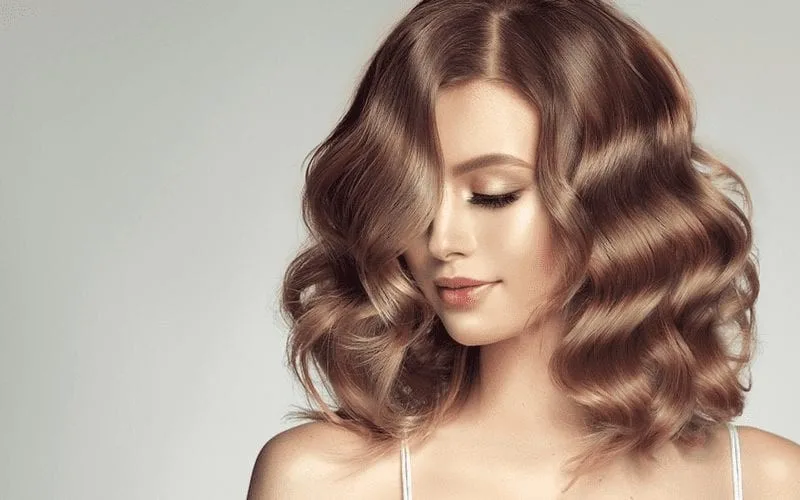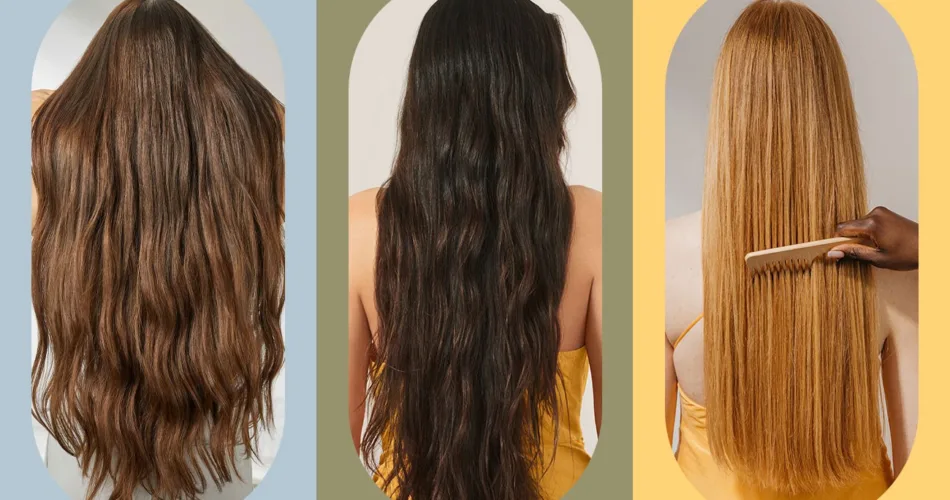In a world where beauty standards often define a specific set of standards, embracing your natural hair texture can be a powerful act of self-love and accuracy. Whether your hair is curly, wavy, or straight, each texture is unique and beautiful in its own way. Your hair texture is the key to accepting your natural beauty, which lies in proper care and styling techniques that enhance rather than change your hair’s natural characteristics. www.naturallycurly.com/hair-types .Embrace the uniqueness of your curls, waves, or straight strands, and celebrate the range that natural hair textures bring to the world of beauty. Remember that confidence in your natural beauty is the most important accessory you can wear, so let your hair shine in its authentic glory. Top of Form This article explores tips and tricks for embracing and enhancing the natural beauty of your hair, regardless of its texture.

Curly Hair:
Curly hair is known for its bounce and volume, but it can also be prone to frizz and dryness. Embracing your natural curls starts with proper care. Use a sulfate-free shampoo to maintain moisture, and consider a deep conditioning treatment to nourish your curls. Avoid excessive heat styling, as it can lead to damage. Instead, opt for air-drying or use a diffuser attachment when blow-drying to enhance your curls’ natural shape. Regular trims can help prevent split ends and maintain the overall health of your curly locks.
Here are some tips for taking care of curly hair:
- Curly hair tends to be dry, so keep it well-hydrated. Use a moisturizing shampoo and conditioner specifically designed for curly hair.
- Steer clear of products containing sulfates and alcohol, as they can strip natural oils and lead to further dryness.
- Detangle your hair when it’s wet using a wide-tooth comb or your fingers to prevent breakage and minimize frizz.
- Treat your curls to a deep conditioning treatment regularly to maintain moisture and improve overall hair health.
- Instead of rubbing your hair with a towel, or using a diffuser to dry your curls. This reduces frizz and helps maintain the natural curl pattern.
- Trim your hair regularly to get rid of split ends and prevent breakage. This helps maintain the shape and health of your curls.
- Switching to a silk or satin pillowcase can reduce friction, preventing frizz and breakage while you sleep.
- Minimize the use of heat styling tools to prevent damage. If you must use them, apply a heat protecting first.
- Stimulate blood circulation by massaging your scalp regularly. Curly hair doesn’t need frequent washing. Consider co-washing between shampoo sessions to maintain moisture.
- All the time touching and playing with your curls can lead to frizz. Try to let your hair be as much as possible.

Wavy Hair:
Wavy hair often falls between curly and straight, offering a unique texture with its own set of challenges and advantages. To enhance your waves, use a lightweight, hydrating shampoo and conditioner to maintain moisture without weighing down your hair. Applying a sea salt spray can accentuate your natural waves for a beach effortless look. When styling, consider loose braids or buns to preserve the natural wave pattern. Embrace the versatility of your wavy hair by experimenting with different styles, from tousled beach waves to sleek and polished looks.
Here are some tips for managing wavy hair:
- Keep your hair well-hydrated by using a moisturizing shampoo and conditioner. Wavy hair tends to be more prone to dryness and frizz, so regular hydration is essential.
- Washing your hair too often can strip it of natural oils, leading to dryness and frizz. Try to wash your wavy hair no more than two to three times a week.
- After applying conditioner, use a wide-tooth comb to detangle your hair gently. This prevents breakage and helps define your waves.
- Apply styling products such as mousse or curl-enhancing creams when your hair is still wet. This helps in distributing the product evenly and defining your waves.
- Instead of rubbing your hair with a towel, gently scrunch it to absorb excess water. Rubbing can create friction and lead to frizz.
- If you prefer using a blow dryer, attach a diffuser to maintain your hair’s natural texture. This helps reduce frizz and encourages the formation of beautiful waves.
- Sleep on a silk pillowcase to reduce friction and prevent frizz. You can also loosely braid your hair before bedtime to help maintain your waves.
- If you use heat styling tools, make sure to use a good quality heat-protecting spray and set the tools at a moderate temperature to avoid damage.
- Treat your wavy hair to a deep conditioning treatment once a week to keep it nourished and healthy.
- Celebrate your natural waves by choosing hairstyles that enhance rather than fight against your hair’s texture. Embracing your waves can simplify your hair care routine and keep your hair looking its best.

Straight Hair:
Straight hair exudes simplicity and elegance, but it requires its own set of care routines. To maintain a sleek look, use a smoothing shampoo and conditioner to control frizz. Regular trims help prevent split ends, keeping your straight hair looking polished and healthy. If you’re looking to add some texture, consider using a volumizing mousse or texturizing spray for a subtle lift. Straight hair is also versatile, allowing for a variety of styles such as sleek ponytails, straight and shiny, or soft waves with the help of styling tools.
Here are some tips for maintaining straight hair:
- Invest in a good quality hair straightener to ensure effective and safe straightening. Look for one with adjustable heat settings to avoid excessive heat damage.
- Before using heat styling tools, apply a heat protecting spray or serum to create a barrier between your hair and the heat. This helps prevent damage and keeps your hair looking healthy.
- Begin the straightening process with clean, dry hair. Using a clarifying shampoo can help remove any product buildup, making the straightening process more effective.
- Divide your hair into small sections before straightening. This makes it easier to manage and ensures that each strand is straightened evenly.
- Adjust the heat settings on your straightener based on your hair type. Fine hair requires less heat than thick or coarse hair. Using excessive heat can lead to damage over time.
- Work with small sections of hair at a time for better results. This allows you to have more control over the straightening process and ensures that each strand is straightened thoroughly.
- Healthy hair starts from within. Ensure your diet includes a variety of nutrients, including vitamins and minerals that promote hair health, such as biotin, vitamin E, and omega-3 fatty acids.
- Schedule regular trims to eliminate split ends and maintain the overall health of your hair. This prevents breakage and helps keep your hair looking sleek and straight.
- While straightening, avoid going over the same section of hair multiple times to minimize heat damage. If needed, use a lower heat setting and increase it gradually.
- Use a deep conditioning treatment regularly to keep your hair hydrated and nourished. This helps combat dryness and frizz, contributing to smoother, straighter hair.
- Before bedtime, loosely tie your hair or use a silk or satin scarf to protect it while sleeping. This helps maintain the straightened look and reduces friction.

Kinky Hair:
Kinky hair is a unique and beautiful hair texture that is characterized by tight curls and coils. This hair type is commonly found in people of African descent, though it can also be present in individuals from other ethnic backgrounds. The term “kinky” refers to the natural curl pattern of the hair, which forms tight, spring-like coils. This texture is often associated with strength, resilience, and a rich cultural heritage. One of the distinctive features of kinky hair is its coil pattern, which can range from tight corkscrews to zigzag shapes. This curl pattern is a result of the hair follicles having an oval or elliptical shape, as opposed to the round shape found in straight hair. Kinky hair tends to be more porous than other hair types, making it prone to dryness. However, with proper care and maintenance, individuals with kinky hair can achieve healthy, vibrant locks.
Here are some tips for kinky hair care:
- Treat your kinky hair to deep conditioning treatments regularly. Choose products with natural oils like coconut, olive, or argan oil to restore and maintain moisture levels.
- Incorporate natural oils like jojoba, castor, or Shea butter into your routine. These oils help seal in moisture and provide additional nourishment to your kinky hair.
- Keep water and leave-in conditioner mixture in a spray bottle. Use it to refresh your hair between washes and maintain moisture levels.
- Kinky hair tends to be dry, so maintaining moisture is crucial. Use a sulfate-free moisturizing shampoo and a hydrating conditioner.


